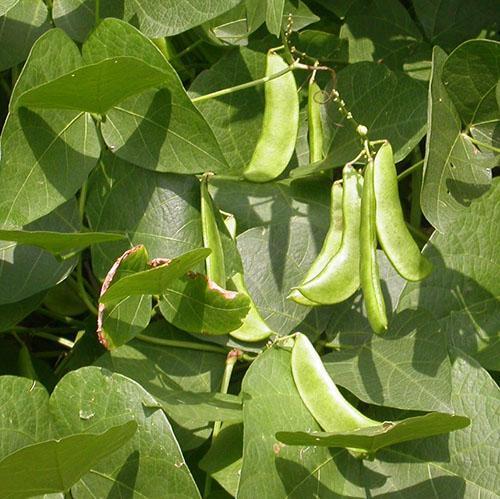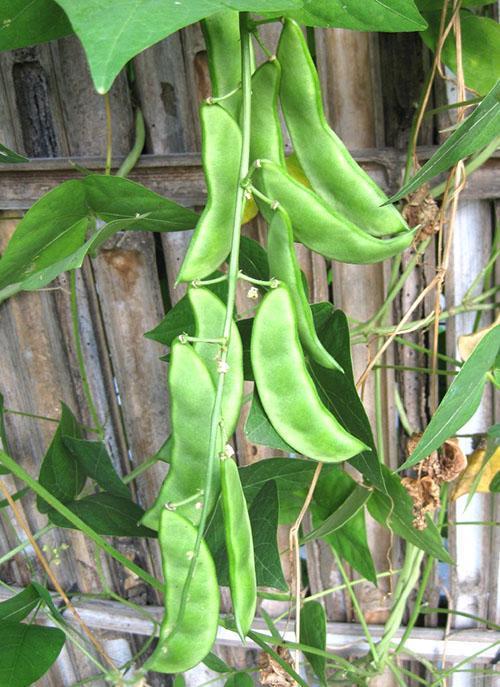An excellent dietary product and a promising garden crop - lima beans
 The South American continent is home to many legumes that are actively used by humans for food. Phaseolus lunatus or lima beans, named after Lima, the capital of Peru, stands out from the line of related species in the appearance, size and taste of the seeds. Large, resembling a slice of tangerine or a growing moon, the seeds brought by the Spanish conquistadors to the Old World turned out to be too thermophilic. Therefore, the first plantations of this type of beans appeared in the subtropical colonies of Europe on the African continent and in Asia.
The South American continent is home to many legumes that are actively used by humans for food. Phaseolus lunatus or lima beans, named after Lima, the capital of Peru, stands out from the line of related species in the appearance, size and taste of the seeds. Large, resembling a slice of tangerine or a growing moon, the seeds brought by the Spanish conquistadors to the Old World turned out to be too thermophilic. Therefore, the first plantations of this type of beans appeared in the subtropical colonies of Europe on the African continent and in Asia.

In Russia, there are still no varieties of butter beans of their own selection or zoned for the existing climatic conditions. But there are successful attempts to grow crops in the open ground in the North Caucasus and Kuban, in the Central Black Earth Region and other parts of the country.
Biological features of lima beans
 Lima beans, like the varieties more familiar to the Russian gardener, are an annual vegetable crop, including a bush and curly form:
Lima beans, like the varieties more familiar to the Russian gardener, are an annual vegetable crop, including a bush and curly form:
- Bush beans are compact and easy to care for. The beans ripen on it 65–80 days after the beginning of the growing season, but the yield of such plants is somewhat less than that of climbing plants.
- Tall curly forms, reaching sizes of 12-15 meters, require a more careful approach to feeding and watering. The moment when lima beans are harvested, in this case, comes after 80–90 days, but the amount of harvested seeds is several times higher than from the same number of bush plants.
 With such a different appearance, both forms have a gray-green dense foliage, bloom, forming large multi-flowered brushes from white, lilac or greenish flowers. But the abundant flowering of this type of beans cannot be called. The flowers open alternately, and sometimes this happens when the pods at the base of the inflorescence are already fully formed.
With such a different appearance, both forms have a gray-green dense foliage, bloom, forming large multi-flowered brushes from white, lilac or greenish flowers. But the abundant flowering of this type of beans cannot be called. The flowers open alternately, and sometimes this happens when the pods at the base of the inflorescence are already fully formed.
The beans, unlike the common beans, are wide, short and flat in this plant.
 The length of the pod ranges from 6 to 18 cm, and only 2-4 seeds are formed inside, which by the time of ripening can become white, grayish, cream or variegated. Another difference between butter beans is a thick layer of coarse fiber inside the valves, so green pods are not eaten, but green, unripe seeds are one of the healthiest and most delicious foods.
The length of the pod ranges from 6 to 18 cm, and only 2-4 seeds are formed inside, which by the time of ripening can become white, grayish, cream or variegated. Another difference between butter beans is a thick layer of coarse fiber inside the valves, so green pods are not eaten, but green, unripe seeds are one of the healthiest and most delicious foods.
With the common taste of existing varieties of lima beans, two groups are traditionally distinguished: with large seeds, 3-4 cm in size and smaller ones, called baby lima.
The value of the plant is not only in large seeds with an oily delicate taste and sweetish aroma. Having grown lima beans on garden beds the gardener can use the green part of this plant as a green fertilizer. Bubbles with nitrogen formed on the roots of beans enrich the soil with this substance, indispensable for plants.
How to grow this type of beans?
 Since lima or moonbeans come from the subtropical region, the plant needs a temperature of at least 18 ° C for comfortable growth, but even on hot days, when the air warms up above 30 ° C, the formation of ovaries is sharply reduced due to the almost sterile pollen.
Since lima or moonbeans come from the subtropical region, the plant needs a temperature of at least 18 ° C for comfortable growth, but even on hot days, when the air warms up above 30 ° C, the formation of ovaries is sharply reduced due to the almost sterile pollen.
It is possible to create conditions acceptable for the species in the open field in regions with a milder warm climate, and in the middle lane you will have to use film greenhouses or greenhouses, especially at an early stage of plant development, when young roots and shoots are most susceptible to temperature drop.
For planting, choose an illuminated area protected from possible drafts. It is better if the predecessors of the Peruvian butter beans on it are plants from the pumpkin or nightshade family:
- Before growing beans, the beds are dug up in the fall and 30-40 g are introduced into the soil per meter of area superphosphate.
- If necessary, the soil is limed at the rate of 300-500 grams of the product per square meter.
- In the spring, prepared ridges are loosened and fertilized with complex compounds at the rate of 30–40 g per square meter.
 Lima beans are sown when the soil is warm enough, that is, its temperature is not lower than 15-16 ° C, and there is no threat of frost. Most often this happens in the last days of May:
Lima beans are sown when the soil is warm enough, that is, its temperature is not lower than 15-16 ° C, and there is no threat of frost. Most often this happens in the last days of May:
- Considering the rapid growth and size of plants, seeds are sown at a distance of 40–50 cm from each other in a square-nesting scheme.
- If lima beans are planted in rows, then a gap of 30–45 cm is left between them, reducing the distance between plants to ten centimeters.
It is reasonable to put arcs over the plantings and cover the crops with non-woven material until the air warms up to 18-25 ° C.
 The cultivation of this type of beans differs little from the agricultural techniques of legumes traditional for the Russian gardener. The main need of a plant during flowering, mass formation and ripening of beans is moisture. But at the same time, accumulation and stagnation of water in the soil is detrimental for lima beans. The fibrous roots of the plant quickly rot, and the beans die.
The cultivation of this type of beans differs little from the agricultural techniques of legumes traditional for the Russian gardener. The main need of a plant during flowering, mass formation and ripening of beans is moisture. But at the same time, accumulation and stagnation of water in the soil is detrimental for lima beans. The fibrous roots of the plant quickly rot, and the beans die.
For climbing varieties, strong supports or trellises are built, otherwise, powerful lashes on the ground will create excessive density, which threatens the development of fungi and bacteria.
Further care for lima beans consists in shallow loosening of the soil, removing weeds and feeding, designed to support plants on soils that are not too rich in nutrition. 10 grams of superphosphate and ammonium nitrate are applied under the bushes per square meter.
Pests and diseases that threaten butter beans
 Compared to common beans, the Peruvian species is more resistant to disease, especially viral and bacterial infections. Of the problems of growing beans, it can be noted that in the second half of summer, foci of true and false lesions are noticeable on plants, powdery mildew and spotted leaves.
Compared to common beans, the Peruvian species is more resistant to disease, especially viral and bacterial infections. Of the problems of growing beans, it can be noted that in the second half of summer, foci of true and false lesions are noticeable on plants, powdery mildew and spotted leaves.
The bean weevil is not terrible for butter beans, but aphids, thrips and spider mites can be seduced by powerful foliage and young shoots. Frequent guests on plants and caterpillars. Diseases include powdery mildew, fungal leaf blight, and some viruses.
When to harvest beans and how to store them in winter?
 Depending on the variety and shape of the plant, the lima bean harvest begins 18-14 weeks after germination. On bush plants, ripening occurs a little earlier, and on tall climbing varieties, if the weather permits, it can take a month. Green seeds for dietary meals rich in protein, vitamins and dietary fiber are harvested earlier, until their skin is rough and the flesh remains juicy.You can store fresh green seeds not only for 10-14 days in a refrigerator.
Depending on the variety and shape of the plant, the lima bean harvest begins 18-14 weeks after germination. On bush plants, ripening occurs a little earlier, and on tall climbing varieties, if the weather permits, it can take a month. Green seeds for dietary meals rich in protein, vitamins and dietary fiber are harvested earlier, until their skin is rough and the flesh remains juicy.You can store fresh green seeds not only for 10-14 days in a refrigerator.
If you want to pamper your loved ones with Peruvian beans in winter, juicy shelled seeds are blanched for about 2 minutes, cooled and dried, and then, laid out in bags or containers, they are frozen.
If desired, the harvested crop of beans can be preserved. Green beans will be an excellent ingredient for winter salads, complement a side dish for meat dishes and fish.
 After hulling, ripe dried seeds are poured into glass jars with tight-fitting lids. In winter, beans can be stored in this form for up to 4–6 months, but only in a cool, dark place where there is no danger of moisture and pests entering the container.
After hulling, ripe dried seeds are poured into glass jars with tight-fitting lids. In winter, beans can be stored in this form for up to 4–6 months, but only in a cool, dark place where there is no danger of moisture and pests entering the container.
Since the seeds contain a lot of proteins, fats and starchy substances, if the storage rules are not followed in winter, the beans may lose not only their taste, but also most of the nutrients.